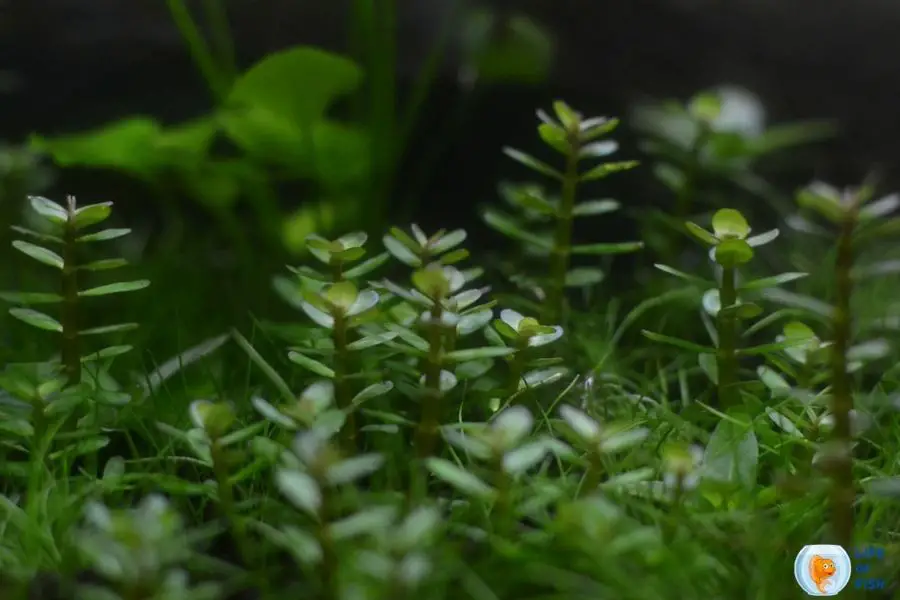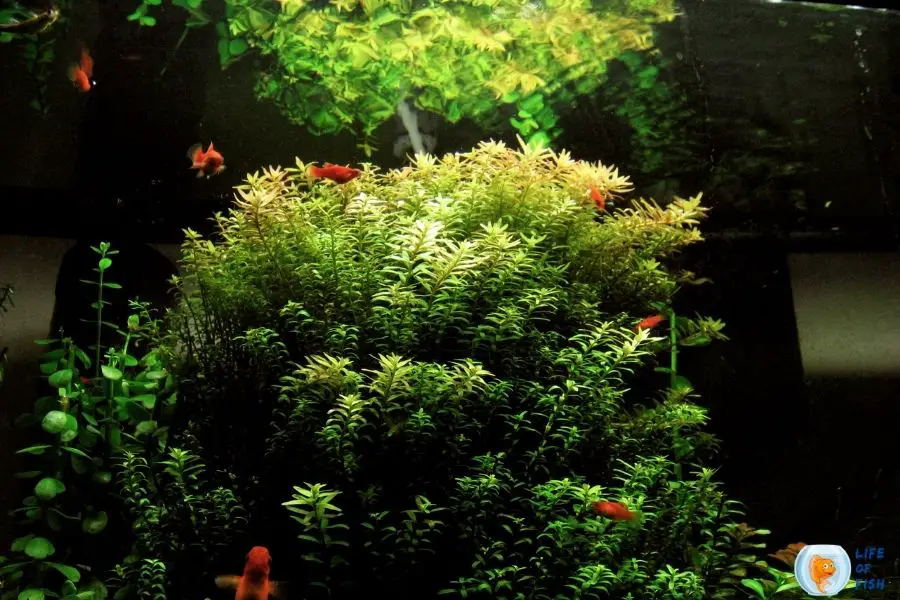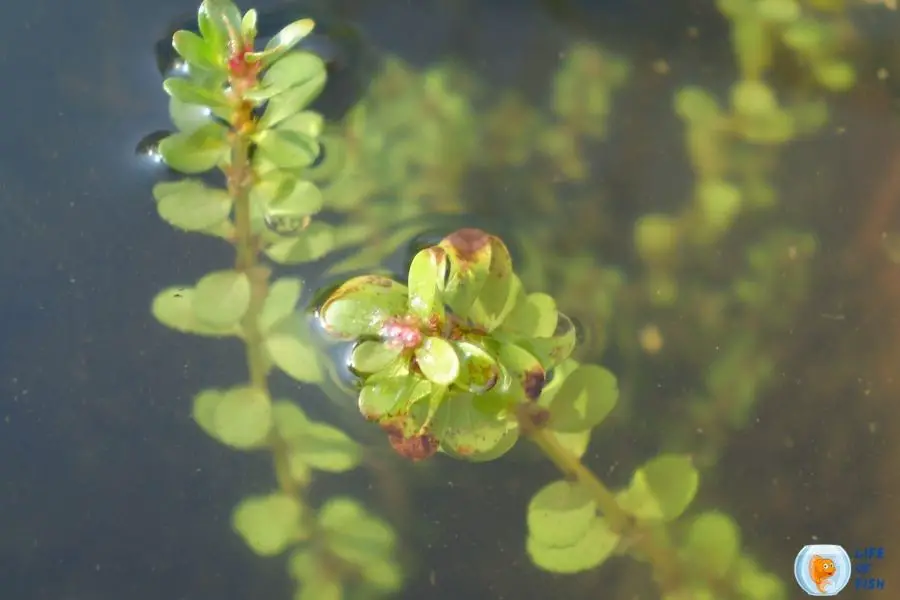Originating from wetlands and rice paddies in India, Rotala Indica is a beautiful flowering plant popular in aquariums. For decades, this plant was misidentified as Rotala Rotundifolia.
Rotala Indica is an aesthetically pleasing aquarium plant that can grow both submerged and emerged. So, many hobbyists adore this plant for decorating their aquariums.
In this guide, you will find everything you need to know about Rotala Indica care and more tips.

What is Rotala Indica?
Jump To
- 1 What is Rotala Indica?
- 2 Benefits of Rotala Indica aquarium plant
- 3 How to identify?
- 4 Is Rotala Indica easy to grow?
- 5 Distribution & Natural Habitat
- 6 Difference between Rotala Indica and Rotala Rotundifolia
- 7 One look Care guide
- 8 Aquarium Care requirements
- 9 Can you float Rotala Indica?
- 10 How fast does Rotala Indica grow?
- 11 How to trim Rotala Indica?
- 12 Does Rotala Indica need CO2?
- 13 How do you propagate Rotala Indica?
- 14 Can Rotala Indica grow out of water?
- 15 Rotala Indica Tankmates
- 16 Where can I buy Rotalia Indica?
- 17 Conclusion
It is commonly known as Indian Toothcap, and it is a flowering plant that belongs to the Lythraceae family and Rotala genus.
Originating from wetlands and rice paddies in India, Rotala Indica is a beautiful flowering plant popular in the aquarium hobby.
For decades, this plant was misidentified as Rotala Rotundifolia.
This plant was first discovered by a German botanist named Bernhard Adalbert Emil Koehne (1848-1918) in 1881.
Later, it was brought into countries like the United States, Italy, Spain, Portugal, and even the Democratic Republic of the Congo.
Many aquarists prefer this plant because of its beauty, benefits, and ability to “Bonsai” underwater.
Benefits of Rotala Indica aquarium plant
Obviously, people choose this plant for aesthetic reasons, but growing them in your aquarium has many other benefits.
Indian Toothcap is a flowering plant that can brighten the look of your aquarium. Rotala Indica also provides shade for other plants that require lower light levels.
Like any other aquarium plant, they uses nutrients in the water to thrive.
It absorbs harmful nutrients like Ammonia, Nitrites, and Nitrates that harm aquarium inhabitants and the water quality.
Rotala Indica can help reduce nitrates in your tank by up to 70%.
It also absorbs carbon dioxide in the water and releases much-needed oxygen to the water. So, as you see, they works as a natural filtration system in your aquarium.
Not only that, but also this plant provide shelter for the inhabitants in your aquarium, especially for the fish fry and shy creatures.
Further, its dense vegetation can cover up a considerate space in your aquarium and can serve as food for herbivore fish.
How to identify?
It can be identified by their furry, shiny green, and round leaves that are grouped together tightly on the stem.
The stems are grown upwards and blooms triangle-shaped pink flowers on the top of the stem.
The flowers most likely will have four tiny petals and will be pointed upwards. But, the flowering of this plant in captivity is rare even though it frequently blooms in the wild.
If left to grow freely, this plant can create a bush, growing up to 18 inches in length.
Each leaf has an oblong form and measures 3cm in length. Its hue changes based on the amount of illumination, CO2, and micronutrients fed to it.
However, some varieties of Rotala Indica may feature grass-like leaves that are tall and slightly pointed.
It is best grown submersed but can emerge if desired.
Is Rotala Indica easy to grow?
Growing them in aquariums is not difficult, but Rotala Indica is a slow-growing plant.
If given its preferred conditions, this plant will grow without much hassle. Therefore, this plant is considered a beginner-friendly plant.
Distribution & Natural Habitat
It originates from wetlands and rice paddies in Southeast Asia. This plant grows in shallow water or in the mud.
Rotala Indica is a flowering plant that needs tropical water conditions, plenty of sunlight, and CO² to grow well.

Difference between Rotala Indica and Rotala Rotundifolia
Rotala Indica is similar to Rotala Rotundifolia, although there are some differences. Rotala Rotundifolia has wider leaves, Rotala Indica has thinner curved leaves.
R. Rotundifolia grows up to 18-24 inches, while Rotala Indica only reaches 12-18″ in height.
Rotala Indica is sensitive towards high levels of Nitrates and can show signs of stress if the level gets too high.
There are no known toxins in Rotala Indica, so it is generally safe to keep them with other plants.
However, Rotala Indica needs more nutrients than Rotala Rotundifolia, which can cause problems if you keep sensitive fish like Cardinal Tetra (Paracheirodon axelrodi).
But those fish still does well with Rotala Rotundifolia. Rotala Indica needs stronger lighting than Rotala Rotundifolia.
They does not flower as easily or profusely as Rotala Rotundifolia, but it still creates beautiful pink flowers that are good for your fish to look at.
Rotala Indica grows slower compared to Rotala Rotundifolia.
One look Care guide
| Scientific name | Rotala Indica |
| Common name | Indian Toothcap |
| Care level | Easy |
| Reef Compatible | No |
| Native to | Southeast Asia, Specifically India |
| Color | Bright green with tiny pink flowers |
| Tank size | 10 gallons |
| Preferred temperature | 72°F to 82°F (22-28 °C) |
| Other water parameters | pH- 6-7.5 Hardness- 3 to 8 KH |
| Preferred salinity | No salinity. Freshwater plant |
| Size | 18 inches |
| Growth rate | slow |
| Recommended tank mates | Small fish docile and easy-going fish slow-moving fish |
| Propagation | Seeds stems easy |
Aquarium Care requirements
Caring for Rotala Indica is pretty easy if you provide intense lighting and much nutrients in your aquarium.
However, when providing these requirements, you also have to consider the needs of your aquatic animals.
Sensitive fish like Cardinal Tetra may not tolerate these conditions, so you have to be careful when choosing suitable tank mates for this plant.
Otherwise, this is a beginner-friendly plant that can adapt to most environments with little fuss.
Tank size
To provide stable water conditions and enough space in the aquarium, we recommend growing this plant in a tank with at least 10 gallons of water.
If possible, go for an even bigger tank. It does well in aquariums that have long and wide shapes.
Lighting
In its natural habitats, it gets plenty of sunlight. Therefore, this plant prefers intense lighting in its environment.
Further, it grows best when provided with 18 hours of light as this plant requires strong lighting to thrive well.
You can keep Rotala Indica at around 12 hours of light with a shade to give it an indirect effect.
They grow in low or high light, but it thrives when given bright lighting.
Fertilizers, CO2 & Substrates
Unlike Rotala Rotundifolia, Rotala Indica requires high nutrients, including nitrogen, phosphorus, iron, magnesium, potassium, etc., to grow quickly.
Therefore, we suggest using CO² and liquid fertilizers for this plant to thrive in aquariums.
However, this plant can grow fine without fertilizers and CO2 if the planted tank has fish in it.
When you grow this plant in a fish tank, it absorbs nutrients produced by fish waste.
So, while cleaning the water, it gets its necessary nutrients to grow healthy—moreover, Fertilizers and CO2 help this plant grow faster.
It needs a fine substrate which can be achieved by using a filter or adding some sand to your substrate.
They also needs rich substrates with plenty of nutrients such as laterite and mud.
For best results, add a two inches of sand bed when growing this plant so that it can anchor well and spread the roots to form a bush.
Water quality
Although this is a tropical freshwater plant, it is highly adaptable to a wide range of freshwater environments. However, Rotala Indica prefers slightly acidic, neutral, and alkaline water.
It can grow well between 72°F to 82°F (22-28 °C) with a pH of around 6 to 7.5.
The recommended water hardness is about 3 to 8 KH.
Rotala Indica will do best when kept at the average recommended water temperature for tropical fish.
they can tolerate moderate to high levels of nitrates (20 ppm – 40ppm) and barely tolerates low levels (< 20 ppm).
Temperature
These aquatic plants prefer tropical water conditions in its surroundings but can do well in temperatures between 72°F and 82°F.
Further, it is a hardy plant that can tolerate slight temperature fluctuations.
Placement
Rotala species make a lovely background plant in aquariums. The placement of this plant is pretty straightforward.
You just have to embed the plant firmly in the substrate with tweezers and make sure It is stable enough to support itself. (It takes some trial and error when planting this plant, so we have shared a tip to attach the plant correctly below.)
Further, Rotala Indica can be planted at various levels in an aquarium, from foreground to background or mixed with other plants.
If you want them to show off its beautiful pink flowers, we recommend planting Rotalia Rotundifolia and Rotala Indica together in your aquarium.
Tip: When embedding the plant, keep a slight angle so the substrate can hold the plant, not letting it dislodge.
Can you float Rotala Indica?
It is a stem plant, and most stem plants are floating. Therefore, you can float Rotala Indica if you desire.
They can be left floating in the aquarium as it grows quickly to cover up surface areas with its leaves.
However, this plant looks better when planted on the substrate. Hence, we recommend keeping your plant floating around until it establishes its roots and then transferring the plant into the substrate.

How fast does Rotala Indica grow?
It is a slow-growing plant, and it needs more nutrients and lights to thrive. If you provide fertilizers and CO2, the growth rate will increase.
But, be careful when adding fertilizers to an aquarium with fish in it. If you want a stem plant that needs less pruning, Rotala Indica is the perfect choice for you.
How to trim Rotala Indica?
Pruning Rotalia Indica is simple; you just have to trim the stems when they grow too tall for your liking.
If there are any dead leaves or plant parts, remove them immediately to promote the healthy growth of Rotalia Indica.
Further, Rotala Indica leaves are fragile and can break easily. Therefore, use a pair of sharp scissors or pruning shears when cutting the plant to keep Rotalia Indica looking beautiful.
Does Rotala Indica need CO2?
It does not require CO2 injection for growth in captivity.
However, if you can inject CO2 into this plant, it will help this plant to grow quickly. Rotala Indica will grow faster if you add fertilizers to the aquarium.
Rotala Rotundifolia needs CO2 for healthy growth in an aquarium, but Rotala Indica does not need it.
How do you propagate Rotala Indica?
You can propagate Rotala Indica in two different ways; with seeds or stem cuttings.
Rotala Indica occasionally spreads seeds in the aquarium and reproduces naturally. However, seed propagation is not the most common way to propagate Rotala Indica.
Further, Rotalia Indica propagates quickly through stem cuttings with only one node (the node is the joint where Rotalia Indica leaves grow out).
This plant tends to keep its roots so that it can be transplanted easily into an aquarium.
To propagate the stem cutting, strip off any leaves on the cutting and implant them in the substrate. The freshly cut stem should begin to sprout roots and develop into a new plant.
Can Rotala Indica grow out of water?
It is a freshwater flowering plant. Hence, it can not grow out of water.
Rotala Indica is a stem plant that grows just above the bottom substrate in an aquarium.
Rotala Indica Tankmates
Since this plant has difficulty staying anchored down even without any distractions, you have to choose tankmates carefully. It can go well with docile and easy-going fish.
When growing this plant in your aquarium, you will have to avoid uprooting fish like Silvar dollars, cichlids, Goldfish, and plecos.
Rotala Indica roots are very fragile. When fish dislodge the roots of this plant, they easily break off from the soil and ruin your tank.
Therefore, Rotalia Indica is not suitable for a community tank with medium to large fish.
Rotala Indica can be used in small species tanks like betta tanks, guppy tanks, molly tanks, and other nano planted aquariums.
Further, you can house slow-moving fish species like fancy Goldfish and angelfish with this plant.
Where can I buy Rotalia Indica?
Rotala Indica is not difficult to find. You can buy this plant from pet fish stores, home improvement stores, and online retailers like Amazon.
However, Rotala Indica is expensive because of its beautiful pink flowers.
Conclusion
Rotala Indica is an easy-growing stem plant if planted in a tropical freshwater aquarium. It is a slow-growing plant, but its beauty makes it worthy of your extra patience.
If provided with ideal water conditions, this plant can grow without much help from you. So, if you have suitable tankmates, we strongly advise you to give this plant a shot.
Read Next: Bioluminescent Jellyfish | 7 Illuminating Facts You Must Know |
